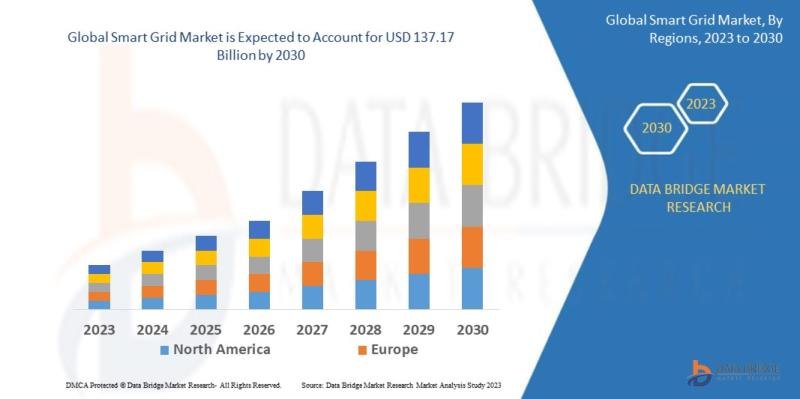The energy industry is undergoing a massive transformation as the demand for efficient, reliable, and sustainable electricity solutions grows. At the forefront of this shift is the smart grid market-a network that uses digital technology to monitor and manage the production and distribution of electricity. This technology optimizes the flow of electricity from producers to consumers, helping to balance demand, reduce waste, and integrate renewable energy sources into the grid. This article delves into the latest trends, market size, growth factors, and demand outlook for the smart grid market leading up to 2030.
Introduction to the Smart Grid Market
A smart grid integrates communication, automation, and information technology with the traditional electrical power grid. Unlike conventional grids, which distribute electricity without feedback or real-time monitoring, smart grids enable two-way communication between utilities and consumers. They employ technologies such as smart meters, sensors, data analytics, and grid automation systems to enhance operational efficiency and minimize energy loss.
The importance of smart grids lies in their capacity to address the growing challenges of modern energy distribution. With urbanization, rising energy demands, and the transition toward renewable sources, traditional grid systems face limitations. Smart grids enable the integration of renewable sources like solar and wind, thereby ensuring a balanced and flexible energy supply. Furthermore, the smart grid market is integral to advancing sustainability goals, energy security, and resilience against disruptions.
Key Trends in the Smart Grid Market
Several key trends are shaping the growth trajectory of the smart grid market, reflecting both technological advancements and shifting energy demands.
Increased Adoption of Renewable Energy
The global shift toward clean energy sources has catalyzed the adoption of smart grids. Countries and companies are investing in solar, wind, and other renewable sources to reduce carbon emissions. However, the variable nature of these sources-solar and wind energy production depends on weather conditions-necessitates a flexible and responsive grid. Smart grids, with their real-time monitoring and load balancing capabilities, are crucial for managing and integrating these intermittent energy sources.
Expansion of Smart Metering Infrastructure
Smart meters are devices that provide real-time data on energy consumption, enabling consumers to make informed decisions about their energy usage. Many governments around the world are promoting smart meter installation to drive energy efficiency. For example, in the United States, Europe, and parts of Asia, governments are mandating or incentivizing smart meter deployment. This expansion is expected to provide utilities with valuable data insights, helping them optimize energy distribution and reduce operational costs.
Grid Modernization Initiatives
Aging infrastructure in many developed countries necessitates grid modernization. Governments are investing in upgrading transmission and distribution networks to handle the increased complexity of modern energy needs. Countries such as the United States, China, and members of the European Union are spearheading large-scale smart grid projects. These modernization initiatives are expected to enhance grid resilience, prevent blackouts, and improve overall reliability.
Increased Focus on Cybersecurity
With the digitization of grids, the risk of cyberattacks on energy infrastructure has increased. Smart grids are often connected to vast networks that, if compromised, could lead to widespread disruptions. This concern has led to greater investments in cybersecurity measures tailored for the energy sector. Industry players are adopting robust security protocols, advanced encryption, and artificial intelligence (AI)-driven threat detection to safeguard the grid from potential cyber threats.
Growth of Energy Storage Solutions
Energy storage plays a pivotal role in the effectiveness of smart grids, as it helps store excess energy generated during low-demand periods and release it during peak times. Lithium-ion batteries, among other technologies, are being deployed to provide reliable energy storage solutions. The integration of energy storage with smart grids enhances grid stability, ensures consistent power supply, and facilitates renewable energy integration.
Access Full 350 Pages PDF Report @ https://www.databridgemarketresearch.com/reports/global-smart-grid-market
Market Size and Share
The smart grid market which was USD 35.6 billion in 2022, is expected to reach USD 137.17 billion by 2030, and is expected to undergo a CAGR of 18.72% during the forecast period of 2023 to 2030. “Component type” segment is dominating the because by type components are critical for applications like power electronics, amplification, and signal processing, making them a dominant force in the market. In addition to the insights on market scenarios such as market value, growth rate, segmentation, geographical coverage, and major players, the market reports curated by the Data Bridge Market Research also include in-depth expert analysis, geographically represented company-wise production and capacity, network layouts of distributors and partners, detailed and updated price trend analysis and deficit analysis of supply chain and demand.
North America currently dominates the market, largely due to significant investments in smart grid technology, a robust regulatory framework, and a high level of consumer awareness. The United States leads the region in smart grid adoption, with several pilot projects and large-scale deployments already underway. Europe follows closely, with countries like the United Kingdom, Germany, and France focusing on smart grid infrastructure to meet stringent carbon reduction targets.
Asia-Pacific is expected to experience the highest growth rate over the next decade. Rapid urbanization, population growth, and government initiatives in countries like China, India, and Japan are propelling the demand for advanced grid solutions. These regions are investing heavily in grid modernization projects and renewable energy integration, making Asia-Pacific a key player in the future of the smart grid market.
Growth Drivers in the Smart Grid Market: Several factors are driving growth in the smart grid market, from regulatory incentives to the increasing urgency for energy efficiency.
Government Policies and Incentives
Many governments are actively promoting smart grid implementation through regulatory measures and financial incentives. For instance, the European Union has introduced a series of directives aimed at enhancing energy efficiency, which include provisions for smart grid deployment. Similarly, the U.S. government has launched initiatives like the Grid Modernization Initiative (GMI) to foster the development of advanced grid technologies.
Rising Demand for Energy Efficiency
Consumers and industries alike are focusing on reducing their carbon footprint and energy costs. Smart grids enable end-users to monitor and optimize energy consumption, contributing to greater efficiency. Utilities also benefit from reduced energy losses, streamlined operations, and lower peak demand costs. The need for energy-efficient solutions across sectors is expected to sustain strong demand for smart grid technology.
Technological Advancements
Emerging technologies, such as the Internet of Things (IoT), machine learning, and big data analytics, are significantly enhancing the capabilities of smart grids. IoT sensors enable real-time data collection, while machine learning algorithms help predict demand fluctuations and optimize resource allocation. As these technologies continue to evolve, the efficiency and reliability of smart grids are expected to improve, spurring further adoption.
Growing Awareness of Climate Change
Climate change concerns are pushing governments, corporations, and individuals to adopt sustainable practices. Smart grids, by facilitating the integration of renewable energy and reducing emissions, align well with global climate goals. The increased awareness of environmental sustainability is a critical factor behind the accelerated adoption of smart grids.
Increased Investment in Renewable Energy
Renewable energy sources are essential to achieving a sustainable energy future. With countries setting ambitious renewable energy targets, the demand for smart grid technology is on the rise. The smart grid market is poised to grow as more countries and regions prioritize renewable energy development and seek efficient ways to integrate these sources into the power grid.
Demand Outlook to 2030
The demand for smart grid technology is expected to continue growing as energy needs evolve. Key drivers include increasing electricity demand, the shift to decentralized power sources, and the widespread adoption of electric vehicles (EVs). The growing popularity of EVs, in particular, will increase electricity demand and require grid enhancements to manage charging infrastructure and balance loads. This trend is likely to further stimulate the market for smart grids in the coming years.
Additionally, as utilities adopt new revenue models-such as time-of-use pricing and demand response programs-smart grids will play a pivotal role in facilitating these shifts. Utilities and consumers alike will benefit from dynamic pricing structures, improved reliability, and enhanced resilience, thereby driving sustained demand for smart grid solutions.
Browse Trending Reports:
https://aimarketresearch2024.blogspot.com/2024/10/cold-chain-testing-market-size-share.html
https://aimarketresearch2024.blogspot.com/2024/10/trace-minerals-in-feed-market-size.html
https://aimarketresearch2024.blogspot.com/2024/10/gluten-free-pasta-market-size-share_26.html
https://aimarketresearch2024.blogspot.com/2024/10/hiking-gear-and-equipment-market-size.html
Conclusion
The smart grid market is set to experience robust growth in the coming years. Driven by technological advancements, regulatory support, and increasing awareness of environmental issues, the demand for smart grids is expected to soar by 2030. With its capacity to address the challenges of modern energy distribution, smart grid technology will play an essential role in the transition to a cleaner, more efficient energy future. As countries worldwide pursue ambitious renewable energy targets and grid modernization projects, the smart grid market stands as a cornerstone of the evolving energy landscape.
About Data Bridge Market Research:
Data Bridge set forth itself as an unconventional and neoteric Market research and consulting firm with unparalleled level of resilience and integrated approaches. We are determined to unearth the best market opportunities and foster efficient information for your business to thrive in the market. Data Bridge endeavors to provide appropriate solutions to the complex business challenges and initiates an effortless decision-making process.
Contact Us:
Data Bridge Market Research
US: +1 614 591 3140
UK: +44 845 154 9652
APAC : +653 1251 975
Email: corporatesales@databridgemarketresearch.com“
This release was published on openPR.



















